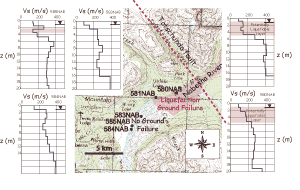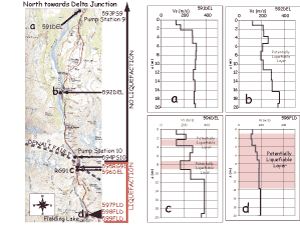
Spacial Character of Liquefaction in Glacial River Systems
 |
 |
 |
|
Geotechnical field investigations: We used a helicopter and a portable SASW unit with hammer source to test 5 Nabesna River sites south of the fault rupture. On the Delta river we drive to test sites and used a harmonic wave source. On the Nabesna river liquefaction ground failure abruptly ends south of test site 581NAB, but continues north all the way to the Tanana lowland at Northway ~60 km away. On the Delta River, liquefaction occurs in pockets of fault-ponded alluvium and isolated spots of low-energy deposition.
Delta River
|
Asymmetry of the Nabesna River ground failures on either side of the fault rupture are the result of steady northward decline in liquefaction resistance intersecting a fault-normal symmetrical (?) ground motion intensity field. Transition from non-liquefied to fully liquefied zones occurred abruptly along a narrow swath on the south side, with no such transition occurring on the north side. |
Delta river liquefaction features are more complex than for the Nabesna. Termination of liquefaction ground failure zones are the result of enormous glacier river inputs of poorly sorted cobble-sand at and below Canwell Glacier. At the fault crossing abundant sand boils are seen along the fault scarp. Fielding and summit lakes are quiet depositional areas of silty sand off Phelan creek. |
Abstract | Index Map 1 | Liquefaction and Ground Displacement | Spacial Character | Surface Wave Testing
Index Map 2 | Liquefaction Damage at Northway Airport | Earthquake Effects on the Trans-Alaska Pipeline
SASW-Site Characterization of Pump Stations 9,10 &11 | Acknowledgments | General Observations | About These Web Pages
Geotech Home Page
 |
 |
 |
 |
 |







